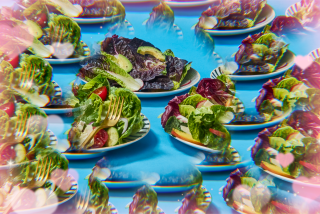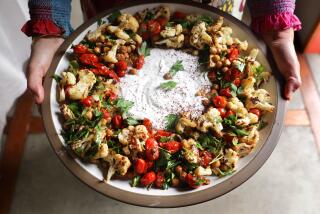Mache Unsnobbed
- Share via
Wild is such a wonderful word, wonderful idea. For those of us who must mind our p’s and q’s, it’s fun to think about life that’s uninhibited.
Mother Nature, of course, has passels of wild children. Corn salad is one of her favorites--she sprinkled its seeds across Europe, North Africa and western Asia. It still grows wild there. In mountain fields of the Caucasus, corn salad grows even more luxuriantly than in the Alps. Pale-blue flowers can wave a foot and a half in the air.
Corn salad was first tamed for kitchen gardens around the 16th Century. The garden variety is small, less than a few inches across, growing in perky rosettes or floppy bouquets. Its leaves are rich green, slightly fleshy and more or less spoon-shaped. They have the nutty flavor and delicate crispness of butter lettuce. Corn salad is also uncommonly nourishing. The leaves contain twice the beta carotene and iron of lettuce and more Vitamin C.
But what’s all this about corn salad? When a friend wanted to buy some, after calling around he couldn’t find corn salad, but he could find mache. That’s its French name-- macher means “to munch.” The French are mad about these leaves. Other French names for them include doucette , which means “demure-looking,” and one that translates as “hare’s ears.”
*
So it’s startling that this unassuming child of the fields has had pretension thrust upon it. When it grew in American gardens in the 19th Century, it was plain old English corn salad. The name springs from its habit of romping around grain fields. Its German name is Feldsalat . An English pet name is lamb’s lettuce.
So here’s a green that needs to be returned to us humble folk. Corn salad couldn’t be easier to grow. All it needs is sun, and water in a drought. Although it grows the year round (it’s perhaps the hardiest salad plant), corn salad is happiest in cool spring and autumn weather. Now is the time to start sowing seeds; keep on sowing through autumn. These are leaves you can depend upon through winter and early spring. (The seeds germinate poorly in hot weather, so shade them till they sprout.)
Harvest corn salad leaf by leaf, or take the whole plant. By all means allow some plants to flower and set seed so you’ll have a fresh supply. Corn salad is an annual (it must be sown each year), but as you can imagine, it self-sows with abandon. Our garden is never without it, and I’ve only sown it once, years ago.
Of course, corn salad has been enjoyed in France, Holland and Italy long enough that a number of cultivars have been developed for different climates and palates. If your summers are hot, sow large-seeded sorts such as Piedmont and Large Seeded Dutch. They have larger leaves, which have better heat resistance. For cold weather harvests, my favorite is Coquille--the leaves are deeply cupped. If you’ve had problems with mildew, choose a resistant strain such as Elan, which has smooth leaves, so moisture doesn’t collect on them easily. Gayla Mache is a newer cold-weather mildew-resistant cultivar. Verte de Cambrai and D’Etampes are longstanding favorites that produce tender, delicious, cold-tolerant leaves.
*
Sometimes, at a farmers’ market or fancy grocery, corn salad/ mache comes with roots attached. If you’re game, try transplanting them. Set about three inches apart in a pot of soil mix and firmly tamp in the roots. If the leaves are large, cut them back to an inch, feed with a half-strength solution of B1 and set the pot in a cool, shady place until they start to grow. Eventually, you can plant them in the garden--or just leave them in the pot. This is a gardening adventure, and if it works, you’re ahead.
Corn salad has one disadvantage, and it’s something catalogues don’t tell you. As tasty and nourishing and lovely and easy as the leaves are, they grow v-e-r-y s-l-o-w-l-y. It will be two if not three months before you’ll have a crop. After that, though, the leaves will keep on coming.
Recipes for corn salad are few and far between, for a couple of reasons, I think. This is such a graceful leaf, it generously enhances every other leaf in a bowl. It’s a favorite in the French tossed-salad-growing-in-the-garden mix called mesclun, and the similar Italian assortment of salad plants called misticanza . Corn salad fanciers seem to be saying, “I’ll keep what I do with these delightful leaves my secret.”
Because of corn salad’s hint of nuttiness, walnuts, hazelnuts and almonds are frequently added to a corn salad, as well as any flavor compatible with nuts. Beets and potatoes are most often suggested, and grapes and violets and johnny-jump-ups. In the same way, dressing with nut oil--walnut or hazelnut especially--is most appropriate to the leaves. When I happened to have a perfect mango on hand as corn salad leaves pushed up from under the snow, I put together a particularly pleasing salad.
*
The entry in the Larousse Gastronomique says corn salad leaves can be cooked like spinach. Well, sure-- any leaf can be cooked like spinach, but that’s not to say it should be. In my experience, this is the rare green that isn’t worth cooking. Definitely intended for salads.
One thing more: Save some large corn salad seeds for the corn rows. As you can imagine, here’s an ideal companion for tall stalks. It loves their shade, and they in turn love the way the low-lying mats retain the earth’s moisture. Besides, it’s fun to get down on your hands and knees beneath the noble corn and pick small leaves--moments in Lilliput. Yes, the wild things of this world are wonderful.
Sources
Fresh: Bristol Farms, local growers markets.
Seeds: Large Seeded Dutch and Verte de Cambrai from Nichols Garden Nursery, 1190 N. Pacific Highway, Albany, Ore. 97321-4580; Gayla Mache from Shepherd’s Garden Seeds, 6116 Highway 9, Felton, Calif. 95018; the rest from the Cook’s Garden, P.O. Box 535, Londonderry, Vt. 05148.
*
If mache is not yet in your garden or easily purchased, instead make this delicious salad with the most delicate green lettuce leaves available . Discard ribs and tear leaves into half-inch pieces.
MANGO AND CORN SALAD
1/4 cup sliced almonds
1 large ripe mango
1 large ripe tangerine
4 cups lightly packed corn salad/mache sprigs and leaves
Generous 1 tablespoon light-tasting oil, preferably hazelnut
Salt
Freshly ground white pepper
Roast almond slices in dry skillet over medium-high heat, shaking skillet, until pale brown. Cool.
Peel mango and cut lengthwise into 1/4-inch slices. Cut slices free of seed. Cut 4 thin rounds from center of unpeeled tangerine. Juice rest of tangerine, to equal 4 teaspoons. Fruits and juice can be wrapped separately and refrigerated several hours.
To compose each salad, make bed of 1 cup corn salad with sprigs intact on salad plate. Sprinkle over 1 tablespoon almonds. Fan out mango slices in same direction from point at edge of plant or make pinwheel of slices around center. Drizzle over scant teaspoon oil, then sprinkle with 1 teaspoon tangerine juice. Set tangerine round at tip of fan or center of pinwheel. Season to taste with salt and white pepper. Makes 4 servings.
Each serving contains about:
130 calories; 78 mg sodium; 0 cholesterol; 8 grams fat; 14 grams carbohydrates; 3 grams protein; 1.12 grams fiber.
* Food styling by Donna Deane and Mayi Brady






